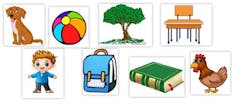As I watched my sons, Wavhudi and Rivhavhudi, play games on my phone before bedtime, I was captivated by their enthusiasm and how deeply they were engaged – especially when the games involved maths or science. Both boys experienced speech delays and I hoped the games would help them develop their language skills. It worked.
What I saw at home has been repeatedly underscored by research: early engagement with science, technology, engineering and mathematics (STEM) concepts through interactive tools can profoundly enhance children’s visual literacy (reading, writing and creating images) and conceptual understanding (grasping ideas).
For my Master’s degree, I’d examined how molecular biology students’ lack of visual literacy made it harder for them to grasp complex scientific concepts. This academic foundation, combined with the newfound spark in my boys, inspired my PhD research: investigating the effects of early STEM education on young children’s visual literacy and ability to grasp scientific concepts.
In a recent, related study, I explored how different types of preschool education influence children’s understanding of science and their ability to interpret visual information. The study involved children aged 4 or 5 years who were in Grade R (the year of schooling before Grade 1) from various private schools in Bloemfontein, South Africa. I observed that those exposed to STEM education were better at spatial visualisation than their peers. These children excelled in tasks that required them to recall and manipulate visual details, such as accurately reproducing elements from images, while their non-STEM counterparts often struggled.
Some people may question why all children should be exposed to STEM concepts, given that not everyone will go on to further study or careers in science, technology, engineering or mathematics fields.
But teaching these skills at a young age is not just about preparing children for specific fields. My findings underscore the profound effects of early STEM education on cognitive development, such as fostering critical thinking, problem-solving skills, creativity, innovation, logical reasoning and adaptability. These qualities are beneficial in many facets of our lives, no matter our career paths.
Testing children’s skills
In South Africa, private schools often have more flexibility than government-run (public) schools to incorporate specialised STEM curricula and innovative teaching methods tailored to early childhood education. This might include hands-on experiments like mixing colours or observing plant growth, problem-solving tasks and interactive learning through, for example, counting games and shape recognition.
Public schools, meanwhile, follow a national curriculum set by the Department of Basic Education. While this includes foundational STEM concepts, not all schools have the necessary resources, so the extent and depth of STEM instruction can vary significantly from school to school.
Though they were private institutions, the non-STEM schools in my study followed the national Curriculum and Assessment Policy Statement set by the Department of Basic Education for Grade R. This does not explicitly emphasise STEM subjects. The STEM schools involved in this study, which were also private institutions, had developed their own curricula that emphasised scientific and related learning.
Drawing from study methods used elsewhere in the world, I created a special test with two main parts to measure my participants’ skills.
One tested their content knowledge. This part assessed how well the children understood basic science concepts, such as distinguishing between living and non-living things. The second evaluated the children’s ability to interpret visual information, including understanding spatial relationships and solving visual problems.
The differences between those who were STEM-educated and those who weren’t were immediately clear.
For example, I showed the children a picture of some blocks and asked them how many blocks they saw. One STEM-educated child said there were nine blocks “because some are hiding behind the others in the picture”. A non-STEM child saw “six blocks because I counted them.”
Author provided (no reuse)
The child with STEM knowledge used advanced thinking skills to imagine where the hidden blocks might be, while their peer only counted the blocks they could see directly.
In another exercise I showed the children a picture with a dog, ball, tree, desk, boy, school bag, book and chicken and asked them to identify which ones were living things.

Author provided (no reuse)
STEM child: “The boy, the dog and the chicken are living because they can breathe and need water to grow.” The child understood what makes something alive, using ideas like breathing and needing water.
Non-STEM child: “Only the boy is living because the dog and chicken can’t talk.”
This is a more basic, less accurate concept of what constitutes a living thing.
Game-changing learning
Based on my findings, I encourage educators to integrate STEM activities into early childhood curricula to cultivate spatial thinking, visual literacy and scientific understanding. Digital educational games and interactive learning experiences can be incorporated into lessons.
Policymakers should prioritise early STEM education, recognising its long-term benefits in preparing children for academic and professional success. This involves investing in resources, training educators, and developing curricula that embed STEM principles from the start of formal education.
My PhD research was born out of my personal experience with my sons. This journey of love, learning and relentless determination reflects my deepest aspiration: to ignite the same passion and curiosity in others that I have witnessed in my own children.

The post “Playing technology games and making science fun helps young kids solve visual problems and grasp ideas better” by Moleboheng Ramulumo, Lecturer, North-West University was published on 08/28/2024 by theconversation.com




































Leave a Reply